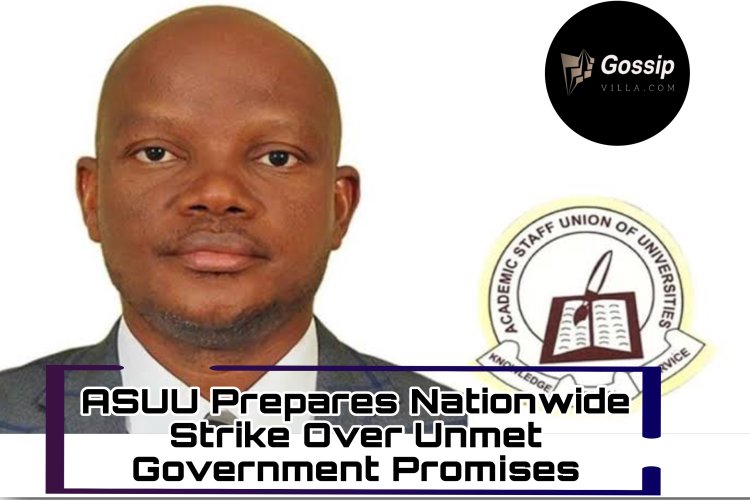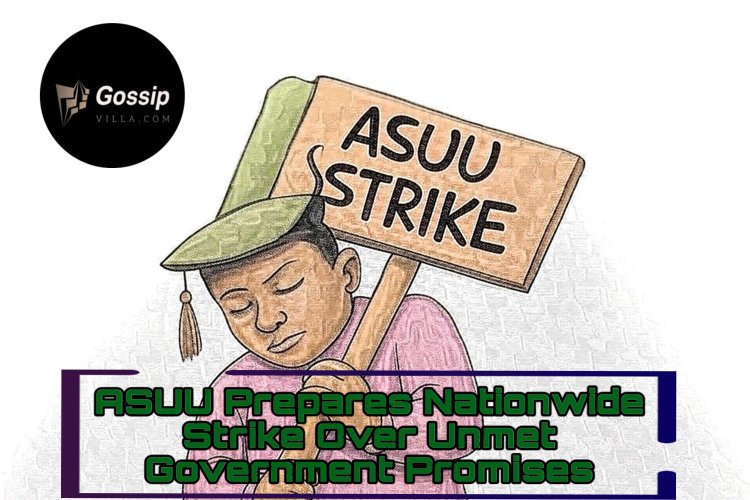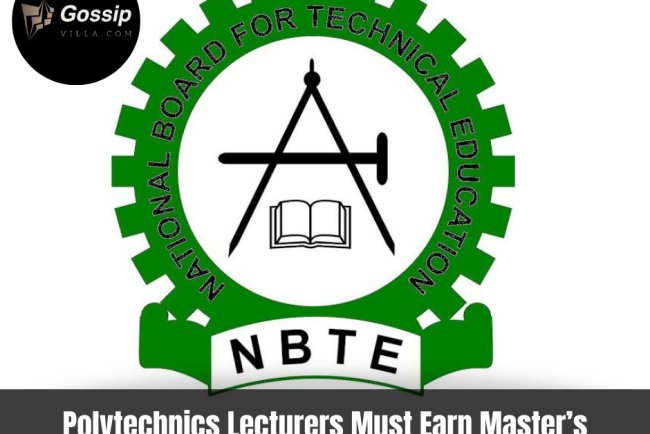ASUU Prepares Nationwide Strike Over Unmet Government Promises
ASUU issues a two-week ultimatum to the Tinubu administration for renegotiating the 2009 agreement, revitalizing universities, and paying allowances, threatening a warning strike escalating to nationwide shutdown if unmet.

ASUU Prepares Nationwide Strike Over Unmet Government Promises
In a development that’s sending shockwaves through Nigeria’s education sector, the Academic Staff Union of Universities (ASUU) has kicked off mobilization efforts across public universities, gearing up for a potential nationwide strike. With the federal government’s silence on long-standing grievances growing louder, lecturers are rallying their members for what could be a two-week warning strike starting as early as September 28, 2025, escalating to an indefinite shutdown if demands aren’t met. This isn’t just about salaries or contracts—it’s a fight for the soul of Nigeria’s higher education system, where underfunding, brain drain, and broken promises have pushed the union to the brink. As students brace for another disrupted semester, let’s unpack the why, the what, and the potential fallout of this brewing crisis.
The Spark
ASUU’s mobilization didn’t happen overnight. The union’s National Executive Council (NEC) issued a stark circular on October 5, 2025, signed by President Prof. Chris Piwuna, directing all branches to prepare for action. This follows a 14-day ultimatum issued after an emergency NEC meeting on September 29, 2025, based on a nationwide referendum where members overwhelmingly backed industrial action.
At the heart of it? The government’s failure to implement the renegotiated 2009 ASUU-FGN Agreement, submitted in February 2025 by the Yayale Ahmed-led committee. This pact, meant to revitalize universities with better funding and welfare, has gathered dust despite repeated pleas. Add to that unpaid salaries from 2022’s eight-month strike—three and a half months’ worth still withheld under the controversial “No Work, No Pay” policy—and delayed June 2025 wages in some branches, and you have a powder keg.
Prof. Piwuna’s letter pulls no punches: “The days ahead call for the mobilization of every member of our union to ensure unity of purpose. No one should be left out of the struggle for our welfare, to stem the Japa syndrome, and reposition the Nigerian University System for global competitiveness.” Zonal coordinators and branch chairpersons are instructed to lead the charge, with members urged to attend congresses and heed directives only from official channels. Earlier rallies in August 2025, like the one planned for August 26, were a prelude, but with no progress post-August 28 NEC meeting, the gloves are off.

Who is ASUU?
For the uninitiated, ASUU isn’t just a union—it’s the backbone of Nigeria’s public universities, representing over 50,000 lecturers in more than 100 institutions. Founded in 1978, the union has a storied history of strikes that have forced governments to the table, from the 1990s funding revamps to the 2009 agreement itself. Under Prof. Piwuna’s leadership since 2024, ASUU has emphasized dialogue but warned that “patience has reached its limit” after two years of Tinubu’s administration without a single major concession.
Their demands are laser-focused: Earned Academic Allowances (EAA), promotion arrears, and a 35% salary increase tied to the 2009 deal. But it’s bigger than paychecks. ASUU is battling the “Japa” exodus—thousands of lecturers fleeing to greener pastures in the UK, Canada, and the US due to poor welfare and infrastructure. Universities are crumbling: labs without equipment, libraries without books, and funding that’s dipped to a paltry 7-10% of budgets, far below UNESCO’s recommended 26% for education. Without resolution, ASUU argues, Nigeria risks producing uncompetitive graduates in a global knowledge economy.
How the Strike Will Unfold
Mobilization is in full swing. Branch leaders are activating strike monitoring teams, suspending academic activities where needed, and ensuring 100% compliance. The two-week warning strike kicks off September 28, 2025, if no “acceptable and satisfactory steps” are taken—think lectures halted, exams postponed, and gates locked. Post-warning, it’s total shutdown: no teaching, no research, no administration until demands are met.
This phased approach is strategic. Past strikes, like the 2022 marathon that cost Nigeria N1.5 trillion in lost productivity, showed the human toll—students idling for months, mental health crises, and delayed national development. But ASUU insists it’s a last resort: “We have kept faith with dialogue… but our patience has reached its limit.” The union’s referendum, with near-unanimous yes-votes for action, underscores the groundswell of support.
Why Now? A Perfect Storm in Nigerian Education
Timing is everything. Nigeria’s universities are already reeling from economic headwinds: inflation at 34%, naira devaluation eroding salaries, and a youth bulge with 70% of the population under 30 clamoring for spots in overcrowded halls. The Tinubu government’s education budget for 2025 allocates just 8.4% of the national spend—below the global average—while TETFund allocations dwindle.
Critics point to political will: Why prioritize palliatives over systemic fixes? ASUU accuses the Ministry of Education and Labour of “tepid responses,” with letters to Ministers Olatunji Alausa and Maigari Dingyadi going unanswered. Meanwhile, private universities boom, widening inequality—public institutions educate 90% of students but get starved of funds.
The Ripple Effects
For the 2 million-plus undergrads in federal universities, this is déjà vu. Past strikes have extended degree programs by a year, fueling dropout rates and youth unemployment, already at 53% for ages 15-24. Parents are furious, with social media ablaze: #ASUUStrikeAgain trends as alumni share horror stories of lost opportunities.
Economically, it’s a body blow. Each strike day costs N5-10 billion in foregone GDP, per experts, hitting research output and innovation. Brain drain accelerates—over 5,000 lecturers “Japa’d” in 2024 alone—leaving classrooms empty and expertise abroad. On the flip side, some hail ASUU’s resolve as a bulwark against complacency, forcing reforms that benefit generations.
Government insiders whisper of backchannel talks, but with the ultimatum ticking, optimism is thin. Vice President Kashim Shettima’s education summit in July 2025 promised action, yet delivery lags.
Voices from the Trenches
ASUU’s base is fired up. “Unity is our weapon,” says Prof. Piwuna, echoing calls for mass participation. Student unions like NANS decry the disruption but urge negotiation: “Don’t punish us for systemic failures.” Civil society groups, including the Education Rights Campaign, back ASUU, demanding full funding.
Yet, whispers of division linger—some branches, paid up on salaries, hesitate—but the NEC’s ironclad directive quells dissent.
The Path Forward
As mobilization intensifies, the ball’s in the government’s court. A swift signing of the 2009 renegotiation, salary releases, and a funding roadmap could avert chaos. But history suggests otherwise—eight strikes since 1999, averaging six months each.
For Nigeria’s youth, this is more than a labor spat; it’s a referendum on priorities. Will the “Renewed Hope” agenda include hope for higher ed? Or will campuses go dark again? ASUU’s mobilization is a clarion call: Act now, or pay later.
News sources
What's Your Reaction?





















